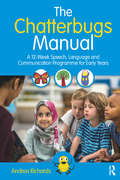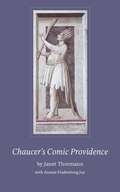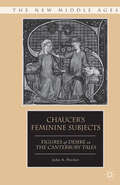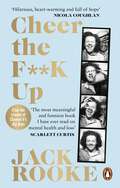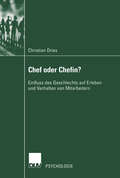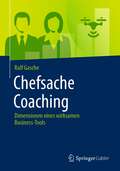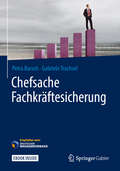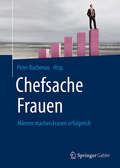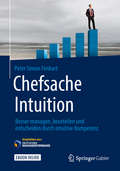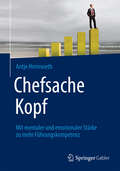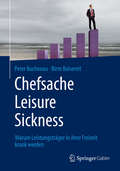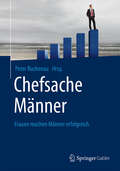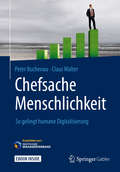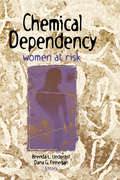- Table View
- List View
Chatbots im Coaching: Chancen im lösungs-fokussierten Coaching (essentials)
by Malte Lömker Ulrike Weber Johannes MoskaliukDieses essential gibt einen fundierten Einblick in die Einsatzmöglichkeiten von Chatbots im lösungsfokussierten Coaching. Es zeigt die Einsatzmöglichkeiten von Chatbots auf, besonders die weniger bekannten im Gesundheitssektor, skizziert deren Möglichkeiten und Grenzen und diskutiert ihre Weiterentwicklung. Basierend auf wissenschaftlich bestätigten Erfolgsfaktoren für Coaching und dem Konzept des lösungsfokussierten Coachings erläutert das essential anschaulich die Umsetzung von Coaching-Prozessen in die „Denkweise und Sprache“ von Chatbots. Als Ausblick diskutiert das essential das Verhältnis Mensch zu Maschine, und wie Chatbots unser jetziges Verständnis von Coaching nachhaltig verändern und bereichern können.
The Chatterbugs Manual: A 12-Week Speech, Language and Communication Programme for Early Years
by Andrea RichardsThe Chatterbugs Manual is a practical resource for all those supporting the development of the foundation communication skills of attention and listening, turn-taking and early vocabulary in children. The Chatterbugs programme has been designed to bridge the gap between education and specialist speech, language and communication provision, specifically with Early Years mainstream settings in mind. It enables school staff to prepare children—including those with delayed communication skills, EAL learners, or children with suspected special education needs—for learning in school by developing their communication skills through the use of robust communication strategies. The Chatterbugs Manual contains: An overview of the programme, including step-by-step instructions on how to plan and deliver a Chatterbugs session Guidance on identifying children likely to benefit from the programme Progress Tracking documents, along with information on measuring outcomes Child-friendly, illustrated session resources Frequently Asked Questions A parent-friendly information leaflet Information on models of implementation Information on accessing training and support Developed by an experienced speech and language therapist, Chatterbugs has consistently recorded successful outcomes for over 80% of participants since the programme’s inception in 2012, and for over 90% of participants since 2016. With its hands-on approach, the programme is an essential resource for educators, support staff, and speech and language therapists working with Early Years children.
The Chatterbugs Manual: A 12-Week Speech, Language and Communication Programme for Early Years
by Andrea RichardsThe Chatterbugs Manual is a practical resource for all those supporting the development of the foundation communication skills of attention and listening, turn-taking and early vocabulary in children. The Chatterbugs programme has been designed to bridge the gap between education and specialist speech, language and communication provision, specifically with Early Years mainstream settings in mind. It enables school staff to prepare children—including those with delayed communication skills, EAL learners, or children with suspected special education needs—for learning in school by developing their communication skills through the use of robust communication strategies. The Chatterbugs Manual contains: An overview of the programme, including step-by-step instructions on how to plan and deliver a Chatterbugs session Guidance on identifying children likely to benefit from the programme Progress Tracking documents, along with information on measuring outcomes Child-friendly, illustrated session resources Frequently Asked Questions A parent-friendly information leaflet Information on models of implementation Information on accessing training and support Developed by an experienced speech and language therapist, Chatterbugs has consistently recorded successful outcomes for over 80% of participants since the programme’s inception in 2012, and for over 90% of participants since 2016. With its hands-on approach, the programme is an essential resource for educators, support staff, and speech and language therapists working with Early Years children.
Chaucer's Comic Providence
by Janet Thormann Aranye Fradenburg JoyChaucer’s Comic Providence presents readings of five of Chaucer’s Canterbury Tales that dramatize sexual division and the lack of rapport between the sexes. These readings are founded on the psychoanalytic thinking of Jacques Lacan in his rereading of Freud and are motivated by Thormann’s conviction that Chaucer understood what psychoanalysis would come to study as an unconscious operating in the subject that is independent of conscious control and desire. For psychoanalysis, the subject is interminably engaged with unconscious sexual difference and with what Lacan saw as the absence of sexual rapport. Chaucer’s Comic Providence analyzes Chaucer’s plots of sexual adventures, mishaps, and surprise to show how the five tales dramatize the lack of symmetry and absence of accord between the sexes. Ultimately, Thormann’s interest here is in the ways these five narratives represent and deal with sexual division, in their means of handling what, in any case, cannot be avoided or mastered. Consequently, the resolutions of the narratives sponsor an ethics of desire: they affirm sexual pleasure and acknowledge misprision and limitation, but they do not compromise, close down, or finish with incompatibility, contraction, and limitation. Her reading, then, claims that Chaucer’s poetry already reveals the unconscious that Freud is credited with discovering. As well, Chaucer not only anticipates Lacan’s pronouncement that “the unconscious is structured like a language,” but also his emphasis on unconscious sexual difference and the absence of rapport between the sexes. With few exceptions, while there has been much consideration of gender in Chaucer’s stories, contemporary criticism of Chaucer has remained inimical or, at the least, largely indifferent, to psychoanalysis, yet because it considers both difference and continuity, change and perpetuation, and because it incorporates psychic processes, motives, functions, and dynamics operating outside of conscious awareness, psychoanalysis offers a wider range for analysis of Chaucer’s tales than does gender theory alone. Chaucer’s Comic Providence also addresses the unexpected, surprising, and providentially comic resolutions of Chaucer’s tales, the concomitant abeyance of sexual conflicts, and the links between emergence and abeyance, which issue in the hope of a beneficent future.
Chaucer's Feminine Subjects: Figures of Desire in The Canterbury Tales (The New Middle Ages)
by J. PitcherThis study shows how contemporary theory can serve to clarify structures of identity and economies of desire in medieval texts. Bringing the resources of psychoanalytic and poststructuralist theory to bear on Chaucer's tales about women, this book addresses those registers of the Canterbury project that remain major concerns for recent feminist theory: the specificity of feminine desire, the cultural articulation of gender, the logic of sacrifice as a cultural ideal, the structure of misogyny and domestic violence. This book maps out the ways in which Chaucer's rhetoric is not merely an element of style or an instrument of persuasion but the very matrix for the representation of de-centered subjectivity.
Cheap Sex: The Transformation of Men, Marriage, and Monogamy
by Mark RegnerusSex is cheap. Coupled sexual activity has become more widely available than ever. Cheap sex has been made possible by two technologies that have little to do with each other - the Pill and high-quality pornography - and its distribution made more efficient by a third technological innovation, online dating. Together, they drive down the cost of real sex, and in turn slow the development of love, make fidelity more challenging, sexual malleability more common, and have even taken a toll on men's marriageability. Cheap Sex takes readers on an extended tour inside the American mating market, and highlights key patterns that characterize young adults' experience today, including the timing of first sex in relationships, overlapping partners, frustrating returns on their relational investments, and a failure to link future goals like marriage with how they navigate their current relationships. Drawing upon several large nationally-representative surveys, in-person interviews with 100 men and women, and the assertions of scholars ranging from evolutionary psychologists to gender theorists, what emerges is a story about social change, technological breakthroughs, and unintended consequences. Men and women have not fundamentally changed, but their unions have. No longer playing a supporting role in relationships, sex has emerged as a central priority in relationship development and continuation. But unravel the layers, and it is obvious that the emergence of "industrial sex" is far more a reflection of men's interests than women's.
Cheap Sex: The Transformation of Men, Marriage, and Monogamy
by Mark RegnerusSex is cheap. Coupled sexual activity has become more widely available than ever. Cheap sex has been made possible by two technologies that have little to do with each other - the Pill and high-quality pornography - and its distribution made more efficient by a third technological innovation, online dating. Together, they drive down the cost of real sex, and in turn slow the development of love, make fidelity more challenging, sexual malleability more common, and have even taken a toll on men's marriageability. Cheap Sex takes readers on an extended tour inside the American mating market, and highlights key patterns that characterize young adults' experience today, including the timing of first sex in relationships, overlapping partners, frustrating returns on their relational investments, and a failure to link future goals like marriage with how they navigate their current relationships. Drawing upon several large nationally-representative surveys, in-person interviews with 100 men and women, and the assertions of scholars ranging from evolutionary psychologists to gender theorists, what emerges is a story about social change, technological breakthroughs, and unintended consequences. Men and women have not fundamentally changed, but their unions have. No longer playing a supporting role in relationships, sex has emerged as a central priority in relationship development and continuation. But unravel the layers, and it is obvious that the emergence of "industrial sex" is far more a reflection of men's interests than women's.
Cheating in School: What We Know and What We Can Do
by Stephen F. Davis Patrick F. Drinan Tricia Bertram GallantCheating in School is the first book to present the research on cheating in a clear and accessible way and provide practical advice and insights for educators, school administrators, and the average lay person. Defines the problems surrounding cheating in schools and proposes solutions that can be applied in all educational settings, from elementary schools to post-secondary institutions Addresses pressing questions such as “Why shouldn’t students cheat if it gets them good grades?” and “What are parents, teachers, businesses, and the government doing to unintentionally persuade today’s student to cheat their way through school?” Describes short and long term deterrents that educators can use to foster academic integrity and make honesty more profitable than cheating Outlines tactics and strategies for educators, administrators, school boards, and parents to advance a new movement of academic integrity instead of dishonesty
Cheating in School: What We Know and What We Can Do
by Stephen F. Davis Patrick F. Drinan Tricia Bertram GallantCheating in School is the first book to present the research on cheating in a clear and accessible way and provide practical advice and insights for educators, school administrators, and the average lay person. Defines the problems surrounding cheating in schools and proposes solutions that can be applied in all educational settings, from elementary schools to post-secondary institutions Addresses pressing questions such as “Why shouldn’t students cheat if it gets them good grades?” and “What are parents, teachers, businesses, and the government doing to unintentionally persuade today’s student to cheat their way through school?” Describes short and long term deterrents that educators can use to foster academic integrity and make honesty more profitable than cheating Outlines tactics and strategies for educators, administrators, school boards, and parents to advance a new movement of academic integrity instead of dishonesty
Cheer the F**K Up: How to Save your Best Friend
by Jack Rooke'Cheer the F**K Up is, without a doubt, the most meaningful and funniest book I have ever read on mental health and loss. Jack is a genius (fact) and he weaves together themes of love, grief, sexuality, trauma, growing up, mental health and friendship in a memoir that will stand the test of time. If you are a human living on this planet YOU NEED THIS BOOK! It has never been more important and never been more needed.' - Scarlett Curtis'Once you've had the pleasure of reading a work by Jack Rooke, you'll have spent time with one of the funniest, warmest, most caring people I've ever known, and he'll feel like your new favourite friend. This book deals with difficult topics in such a beautiful, thoughtful and hilarious way. It's the book we all need in our lives.' - Nicola CoughlanThis book will definitely make you laugh and might just make you cry, but it could also help save a life.Cheer the F**K Up is a bold, brilliant and very personal account of a young comedian’s experiences with mental health. An ode to the importance of friendship, Jack Rooke takes us on a mission to better understand the reasons why so many people are struggling, and how we can all feel better equipped in knowing how to support that one friend we might be that bit more worried about.Part comedic memoir, part advice guide, this book is a fresh and timely take on a huge issue very close to Jack’s heart – in 2015, while working as an ambassador for a male mental health charity, he lost one of his best friends to suicide.Taking you on a journey through his life and experiences with grief, sexuality, depression and more, Jack offers his own frank and powerful advice on how best to have meaningful conversations about a loved one’s state of mind. Hilarious and heart-breaking in equal measure, Cheer the F**K Up will definitely make you laugh and might just make you cry, but it could also help save a life.
Chef oder Chefin?: Einfluss des Geschlechts auf Erleben und Verhalten von Mitarbeitern
by Christian DriesChristian Dries untersucht in einer empirischen Analyse, inwieweit Mitarbeiter durch das Geschlecht ihres Vorgesetzten in ihrem Erleben und Verhalten beeinflusst werden und zeigt die möglichen Auswirkungen für die Zusammenarbeit und Führung in Organisationen auf.
Chefsache Coaching: Dimensionen eines wirksamen Business-Tools (Chefsache)
by Ralf GascheDieses Buch stellt professionelles Business-Coaching als wichtiges Erfolgskriterium für Unternehmen und Führungskräfte in den Blickpunkt. Ralf Gasche bespricht nicht nur ein beiläufiges Phänomen, sondern präsentiert eines der wirksamsten Weiterentwicklungstools der letzten Jahrzehnte, wenn nicht sogar des letzten Jahrhunderts. Dabei stellt er alle wesentlichen Wirkfaktoren sowie die entscheidenden Dimensionen von Business-Coaching vor – ein Must-have für unternehmerisch denkende Akteure in Unternehmen und Organisationen.Dieses Buch eröffnet Unternehmern, Chefs, Führungskräften aller Ebenen und Projektverantwortlichen den Blick hinter die Kulissen von Professional-Coaching. Der Leser erhält Insider-Knowhow zum Faktor Mensch im modernen Wirtschaftsalltag.
Chefsache Fachkräftesicherung
by Peter Buchenau Petra Barsch Gabriele TrachselDas Buch aus der Chefsache-Reihe bietet eine Analyse der aktuellen Situation zum Fachkräftemangel, zeigt Entwicklungen und Handlungsmöglichkeiten auf und gibt Beispiele erfolgreicher Umsetzungen in Unternehmen. Die Wichtigkeit, eine Unternehmensstrategie für die Fachkräftesicherung zu entwickeln, wird verdeutlicht. Durch die demografische Entwicklung stehen Unternehmen vor neuen Aufgaben, wenn sie auch zukünftig qualifiziertes Personal gewinnen und halten möchten. Die Autorinnen gehen den folgenden Fragen nach: Wie entwickelt sich die Verfügbarkeit von gut qualifizierten Arbeitskräften? Warum ist es für Unternehmen schon heute sinnvoll, sich mit dem Fachkräftebedarf in 10, 20 oder sogar 25 Jahren zu beschäftigen? Welche Strategien für die Fachkräftesicherung gibt es? Welche sind erfolgversprechend und welche Veränderungen sind in den Unternehmen notwendig? Beispiele illustrieren die einzelnen Schritte und erfolgreiche Konzepte anschaulich. Die vorgestellten Methoden und Werkzeuge können direkt in der täglichen Praxis angewendet werden.
Chefsache Frauen: Männer machen Frauen erfolgreich (Chefsache)
by Peter BuchenauDieser Band aus der beliebten Reihe "Chefsache" schildert in origineller und innovativer Weise die Erfolgsfaktoren weiblicher Führung. Die durchweg männlichen Beitragsautoren beschreiben, was aus ihrer Sicht Frauen in Führungspositionen erfolgreich macht. So wird das gängige Klischee "Frauen lassen sich von Frauen trainieren, Männer von Männern" auf den Kopf gestellt und neue Perspektiven eröffnen sich. Leserinnen erhalten Karrieretipps sozusagen von Mann zu Frau und werden von der männlichen Sicht auf Frauen in Führungspositionen überrascht sein.
Chefsache Intuition: Besser managen, beurteilen und entscheiden durch intuitive Kompetenz (Chefsache Ser.)
by Peter Buchenau Peter Simon FenkartDas Buch aus der Chefsache-Reihe stellt die Intuition als wichtiges Erfolgskriterium für Entscheidungen und Zieldefinitionen in Unternehmen in den Blickpunkt. Intuition ist die Fähigkeit, komplexe Sachverhalte umfassend zu durchdringen, kritische Faktoren zu erkennen und gedankliche Grenzen zu überwinden. Der Verstand lässt sich durch Glaubenssätze und Neigungen fehlleiten und unterdrückt damit die intuitiven Fähigkeiten. Der Autor zeigt, dass das Trainieren der Intuition die Entscheidungskompetenz stärkt, die Kreativität und Lösungskompetenz fördert, sowie die Fähigkeit ausbaut, mit Menschen umzugehen.
Chefsache Kopf: Mit mentaler und emotionaler Stärke zu mehr Führungskompetenz
by Antje HeimsoethSelbstvertrauen, Selbstbewusstsein sowie ein gutes Selbstmanagement sind Schlüsselfaktoren für den Erfolg – nicht nur im Business. Wie im Spitzensport hilft es auch Managern, sich mental zu coachen. Das Ziel: Volles Leistungspotenzial jederzeit abrufen können. Mentales Training stärkt nicht nur das eigene Leistungsvermögen, sondern auch die Lebensqualität und schult die Wahrnehmung für sich selbst und andere. Dieses Buch zeigt, wie Sie mit Hilfe verschiedener mentaler Techniken an Motivation, Flexibilität, Zielfokussierung und Konzentration gewinnen, Stress und Angst bewältigen, mit Emotionen umgehen sowie Entspannung finden. Dabei schlägt die Autorin Brücken zum Spitzensport und lässt Führungspersönlichkeiten, Experten und Spitzensportler zu Wort kommen, die Einblick in ihr Selbstmanagement gewähren. Konkrete Anleitungen, Grafiken, Übungen und Praxisbeispiele garantieren dem Leser unmittelbare Umsetzungsmöglichkeiten.
Chefsache Leisure Sickness: Warum Leistungsträger in ihrer Freizeit krank werden
by Peter Buchenau Birte BalsereitDas Leisure-Sickness-Syndrom, auch „Freizeitkrankheit“ genannt, betrifft mittlerweile einen großen Anteil der berufstätigen Menschen. Wer viel und konzentriert arbeitet, benötigt dringend Erholung. Aber das scheint unmöglich, wenn man ausgerechnet am Wochenende oder im Urlaub erkrankt. Peter Buchenau und Birte Balsereit zeigen auf, was Führungskräfte und Leistungsträger tun können, um sich in den Erholungsphasen wirksam entspannen und regenerieren zu können. Dadurch, dass die Batterien des Einzelnen wieder aufgeladen werden, können sowohl die Leistungsfähigkeit und Produktivität im Unternehmen als auch die persönliche Lebensqualität wirkungsvoll gesteigert werden. Konkrete Anleitungen, Checklisten, Grafiken, Illustrationen, direkt anwendbare Übungen und Praxisbeispiele garantieren dem Leser unmittelbare Umsetzungsmöglichkeiten. Ein Muss für jede Führungskraft!
Chefsache Männer: Frauen machen Männer erfolgreich
by Peter BuchenauDieser Band aus der beliebten Reihe "Chefsache" schildert in origineller und innovativer Weise Faktoren für den Erfolg männlicher Führungspersonen. Die Beitragsautorinnen beschreiben, was aus ihrer Sicht Männer in Führungspositionen erfolgreich macht. So wird das gängige Klischee "Frauen lassen sich von Frauen trainieren, Männer von Männern" auf den Kopf gestellt und neue Perspektiven eröffnen sich. Die Leser erhalten Karrieretipps aus weiblicher Sicht und werden überrascht sein von den Erfolgsrezepten, die Frauen für sie in petto haben.
Chefsache Menschlichkeit: So gelingt humane Digitalisierung (Chefsache Ser.)
by Peter Buchenau Claus WalterDieses Chefsache-Buch stellt die Menschlichkeit der eigenen Person als wichtiges Kriterium für Karriere-, Führungs- und Verkaufserfolge in den Mittelpunkt. Denn der Mensch ist kein Roboter, keine zu optimierende Hard- oder Software. Er funktioniert nach wie vor analog – ein emotionales Wesen, das mit eigenem Willen, Intuition und Menschlichkeit entscheidet und entscheiden sollte. Dadurch hat er einen langsameren Entwicklungszyklus als die Digitalisierung. Wie lässt sich die Lücke der unterschiedlichen Geschwindigkeiten schließen? Welche Verbindungen braucht es zwischen Mensch und Informatik/Robotik? Welchen Einfluss hat die Digitalisierung auf den Menschen und wie kann sie im Unternehmen erfolgreich bewältigt werden? Die Autoren stellen innovative Denkansätze vor und wagen einen visionären wie bodenständigen Blick in die Zukunft – voller Inspiration, das Morgen im Heute auf humane Weise einzuleiten und zu begleiten. Es braucht „Menschlichkeit 5.0“ parallel zur Digitalisierung, damit „Society 5.0“ Realität werden kann.
Chemical Dependence: Diagnosis, Treatment, and Prevention
by H. Thomas MilhornThe author has organized basic, core information on the diagnosis, treatment and prevention of chemical dependence into a readily understandable format. His approach teaches the physician what steps to take from a practical point of view: how to prevent addiction in the first place, how to diagnose the condition, how to aid the family get the addict into treatment, and how to increase the chances of long-term recovery. The book is divided into three sections. The first section covers basic definitions and concepts. The second section describes the pharmacology of the various psychoactive substances: depressants, opioids, stimulants, cannabinoids, hallucinogens, phencyclidines, and inhalants. The third section discusses chemical dependence in special groups: women, adolescents, the elderly, ethnic minorities, dual diagnosis patients, HIV- positive patients, and impaired physicians.
Chemical Dependency: Women at Risk
by Dana Finnegan Brenda UnderhillChemical Dependency: Women at Risk shows readers how to design and implement drug and alcohol treatment programs that take into account not only gender but also the cultural differences among women. Whether you’re a counselor, researcher, or health care provider, this book will show you how to abandon ‘one-size-fits-all’treatment approaches that fail to address the individual needs of women undergoing substance abuse treatment. Instead, you’ll learn to recognize and respect cultural and individual differences among women. Use this book as a guide to develop your own innovative multicultural treatment approaches to substance abuse. Chemical Dependency offers a three-stage cultural assessment model that serves as a key starting point for transforming your services into culture-, gender-, and ethnic-sensitive programs. You’ll acquire the knowledge and skills necessary to develop recovery services that identify patterns of belief and customs that can assist or hinder women in achieving and maintaining recovery.Readers of Chemical Dependency discover the obstacles to the development of effective women&’s recovery programs, as well as key service elements of successful recovery programs. In addition, they witness firsthand how to integrate an understanding of women&’s lives from a multigenerational and life span perspective with consideration of issues such as sexuality, violence and sexual abuse, and codependence and parenting. As a result, professionals in the field at all levels are equipped with the necessary know-how for providing services to underserved women and offering them the assistance they so desperately need to overcome their substance abuse problems.Chemical Dependency provides readers with the most comprehensive analysis to date of marijuana addiction in women with effective methodss for outreach, intervention, treatment, and research. The techniques it offers for establishing discussion frameworks for sexuality and HIV in the context of recovery can be incorporated immediately into existing treatment programs, as can its strategies to assist lesbians and bisexual women in confronting the trauma they suffer as a result of addiction, sexism, and societal homophobia.The book&’s authors are professionals in the fields of treatment, research, prevention, community organizing, and policymaking. Readers acquire from their collaborative effort an understanding of alcohol and drug addiction as a complex ‘bio-psycho-social-spiritual’disease. Counselors, researchers, health care providers, and faculty and students of chemical dependency programs will find Chemical Dependency an invaluable guidebook for the development or improvement of their own approaches to successful intervention and treatment of women susceptible to drug and alcohol abuse.
Chemical Dependency: Women at Risk
by Dana Finnegan Brenda UnderhillChemical Dependency: Women at Risk shows readers how to design and implement drug and alcohol treatment programs that take into account not only gender but also the cultural differences among women. Whether you’re a counselor, researcher, or health care provider, this book will show you how to abandon ‘one-size-fits-all’treatment approaches that fail to address the individual needs of women undergoing substance abuse treatment. Instead, you’ll learn to recognize and respect cultural and individual differences among women. Use this book as a guide to develop your own innovative multicultural treatment approaches to substance abuse. Chemical Dependency offers a three-stage cultural assessment model that serves as a key starting point for transforming your services into culture-, gender-, and ethnic-sensitive programs. You’ll acquire the knowledge and skills necessary to develop recovery services that identify patterns of belief and customs that can assist or hinder women in achieving and maintaining recovery.Readers of Chemical Dependency discover the obstacles to the development of effective women&’s recovery programs, as well as key service elements of successful recovery programs. In addition, they witness firsthand how to integrate an understanding of women&’s lives from a multigenerational and life span perspective with consideration of issues such as sexuality, violence and sexual abuse, and codependence and parenting. As a result, professionals in the field at all levels are equipped with the necessary know-how for providing services to underserved women and offering them the assistance they so desperately need to overcome their substance abuse problems.Chemical Dependency provides readers with the most comprehensive analysis to date of marijuana addiction in women with effective methodss for outreach, intervention, treatment, and research. The techniques it offers for establishing discussion frameworks for sexuality and HIV in the context of recovery can be incorporated immediately into existing treatment programs, as can its strategies to assist lesbians and bisexual women in confronting the trauma they suffer as a result of addiction, sexism, and societal homophobia.The book&’s authors are professionals in the fields of treatment, research, prevention, community organizing, and policymaking. Readers acquire from their collaborative effort an understanding of alcohol and drug addiction as a complex ‘bio-psycho-social-spiritual’disease. Counselors, researchers, health care providers, and faculty and students of chemical dependency programs will find Chemical Dependency an invaluable guidebook for the development or improvement of their own approaches to successful intervention and treatment of women susceptible to drug and alcohol abuse.
Chemical Dependency: Theoretical Approaches and Strategies Working with Individuals and Families
by Eileen B IsaacsonThis helpful book underscores the importance of working with both the individual and family as part of a comprehensive biopsychosocial approach in assessment, intervention, and treatment of chemical addiction. With many case studies highlighting the treatment guidelines, Chemical Dependency is an ideal guide for professionals and students in addictions studies, mental health, and other human service related fields intent on working with and providing services to individual and family addiction.
Chemical Dependency: Theoretical Approaches and Strategies Working with Individuals and Families
by Eileen B IsaacsonThis helpful book underscores the importance of working with both the individual and family as part of a comprehensive biopsychosocial approach in assessment, intervention, and treatment of chemical addiction. With many case studies highlighting the treatment guidelines, Chemical Dependency is an ideal guide for professionals and students in addictions studies, mental health, and other human service related fields intent on working with and providing services to individual and family addiction.
Chemical Dependency and Antisocial Personality Disorder: Psychotherapy and Assessment Strategies
by Bruce Carruth Gary G ForrestChemical Dependency and Antisocial Personality Disorder gives you the information and clinical skills necessary to assess and evaluate persons suffering from substance abuse and/or antisocial personality disorders and details how you can develop effective psychotherapy and treatment strategies. From its helpful pages that contain diagnostic criteria and clinical interviewing and assessment guidelines, you learn to accurately diagnose substance use and antisocial personality disorders. The book also provides you with the historical and clinical perspectives of such disorders and their epidemiology and etiology to give you a thorough background and understanding of the subject. Case studies and therapy vignettes are included to provide you with actual clinical examples to illustrate concepts and ideas. You will appreciate the book’s in-depth discussions of treatment strategies that can greatly enhance your effectiveness. You’ll find this volume is an invaluable research resource for refreshing your approaches for helping persons with substance abuse and antisocial personality disorders.Much of the content of Chemical Dependency and Antisocial Personality Disorder is based on the author’s two decades of experience working with patients suffering from substance use and antisocial personality disorders. Some topics addressed include: accurate differential diagnosis resistance the use of structure in treatment therapist-patient relationship dynamics treatment outcome effectiveness, relapse, and recovery. Alcohol/drug counselors, psychiatrists, psychologists, and corrections, probation, and parole officers who want to be more effective in their work with chemically dependent and antisocial clients will find this a practical, helpful, and informative guide. This enlightening book examines many of the most difficult and clinically problematic issues that are associated with the psychotherapy and rehabilitation of chemically dependent and/or antisocial patients. Much of the content of Chemical Dependency and Antisocial Personality Disorder is based on the author’s two decades of experience working with patients suffering from substance use and antisocial personality disorders. Some topics addressed include accurate differential diagnosis, resistance, the use of structure in treatment, therapist-patient relationship dynamics, and treatment outcome effectiveness, relapse, and recovery. Alcohol/drug counselors, psychiatrists, psychologists, and corrections, probation, and parole officers who want to be more effective in their work with chemically dependent and antisocial clients will find this a practical, helpful, and informative guide.

